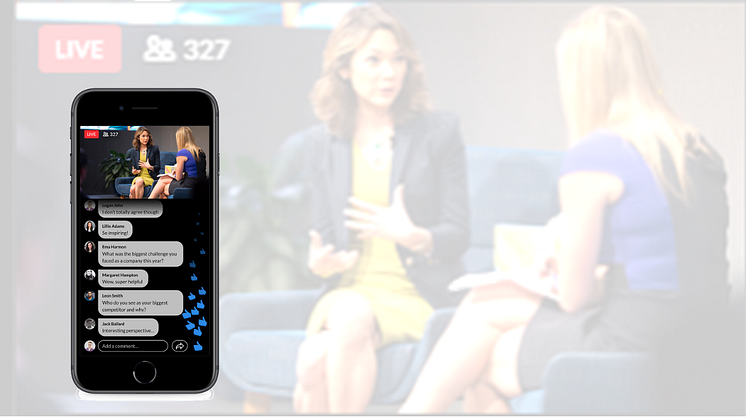
Blog post -
LinkedIn Live video streaming - different from all the rest
People who are saying LinkedIn Live is late to the video live streaming party are missing the point. The network is designed for business people sharing meaningful, valuable content - and that will apply to live video, too.
I cannot overstate the significance of this. Discount all those headlines that say LinkedIn is late, that it is imitating YouTube, or "better late than never". Senior business leaders who want to make a success of LinkedIn Live will have to take an entirely different approach, and one which they should apply to all their communications.
TechCrunch, which broke the story, writes: "The plan is to cover conferences, product announcements, Q&As and other events led by influencers and mentors … earnings calls, graduation and awards ceremonies and more."
Mashable adds: "The social network is clearly looking to shape the content streamed on the service, at least at first, by using it to support users looking to broadcast conferences, company announcements, earnings calls, and other similar events."
YouTube might have been first, followed by Twitter (which bought Periscope) or Facebook/Instagram. But look at the trash that's on these! To think your serious business content is in the same timeline as Russian car crash videos on YouTube, dog and cat videos on Facebook, or narcissistic self-promotion on Instagram!
The biggest winners will be organisations which live stream engaging, relatable business content, such as quarterly earnings announcements and conferences (this will eat the lunch of Conference Service Providers in the process).
But in producing it, you have to start from scratch. When producing a video stream for LinkedIn Live, think "Harvard Business Review" and "TED" - not "viral video" and "quirky skits".
In fact, you need to go one step further. No one has yet cracked live video streams as a replacement for face-to-face interactions. As Simon Sinek writes in Leaders Eat Last:
"Real, live human interaction is how we feel a part of something, develop trust and have the capacity to feel for others. It is how we innovate. It is why telecommuters never really feel like they are a part of the team as strongly as the ones who go to work every day. No matter how many e-mails they send or receive, no matter how kept in the loop they are, they are missing all the social time, the gaps, the nuance… the humanity of being around other humans." (page 141)
As a TV producer let me tell you: it's very difficult to build "social time, gaps and nuance" into a live stream. But let's try:
- Start early - Often live streams start with a holding slide. Why? You can provide a semblance of social time by pointing the camera at the stage even as your speakers are still settling in their chairs a few minutes before the official time of the webcast. Or point the camera at the audience so you can see people mingling. You might want to mute the audio and of course make everyone aware that they are on-camera as soon as they enter the auditorium or meeting room that they are already live. But this adds a whole lot of atmosphere and brings your virtual audience into the fold in a way a holding slide never can. If you want to make the most of LinkedIn Live, go beyond the ordinary.
- Hologram video - Recently I was part of a hologram stream for a private bank event. It was remarkable how much of a difference it makes when you see the speaker appear on stage virtually in 1:1 size, rather than a headshot. This flips the virtual/physical relationship between the audience and speaker on its head, but is surprisingly effective to make people feel they are in the same room together. And it's cheaper than virtual presence.
- Address your audience - Most presenters address either the audience that is physically present at the event, or a live-stream-only audience. Needless to say you should address both. Ask me how.
- Absolutely no scripting - The great strength of live video streaming is the spontaneity, dynamism and energy that comes with going live. You can't bring in nuance and empathy for your audience when you're reading from a teleprompter. To maximise the reputation for authoritative content on LinkedIn, and to cement your reputation as a subject matter expert, ditch those scripts when streaming on LinkedIn Live.
- Interact! - The other great strength of live video streaming is the opportunity to respond to viewer questions, yet I still see the Q&A tacked on at the end of presentations. That might have been okay for YouTube Live or Facebook Live, but let's be real: your audience on LinkedIn is likely to be much smarter, much more sophisticated than a general audience. Don't insult their intelligence. Invite questions early, and respond to them as part of the conversation without holding them over until the Q&A segment at the end.
- It’s okay to have light and shade - Gaps are difficult to infuse into a live webcast because viewers will wonder why you've stopped. At worst, it gives them an opportunity to tune out. But when going live there is no reason you can't introduce some light and shade, times when the conversation and content is heavy and complicated, other times when the conversation is lighter and breezier.
Just as you know LinkedIn is different from Facebook, so too you should approach your LinkedIn Live feeds differently from Facebook Live. If you don't, you are doing yourself and your sophisticated business audience a disservice.
